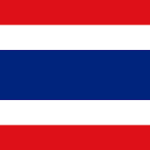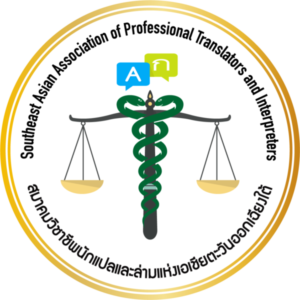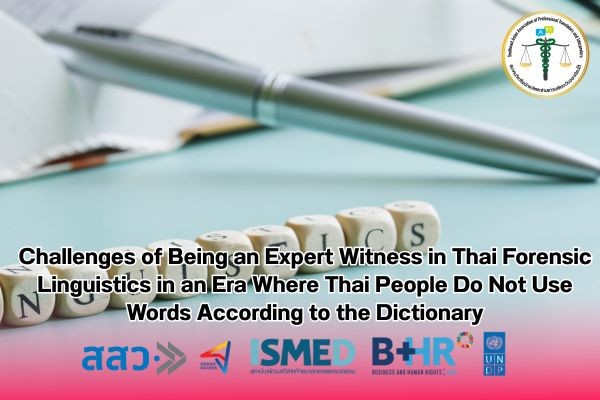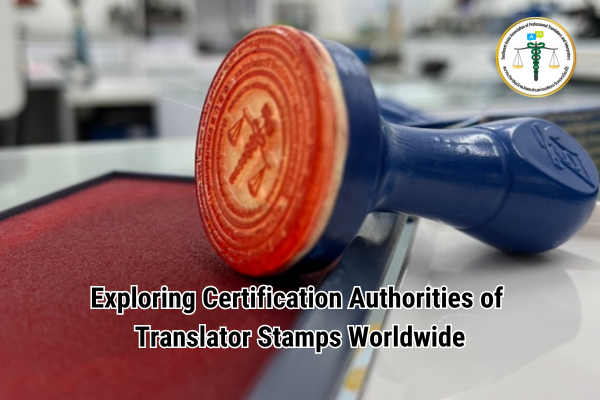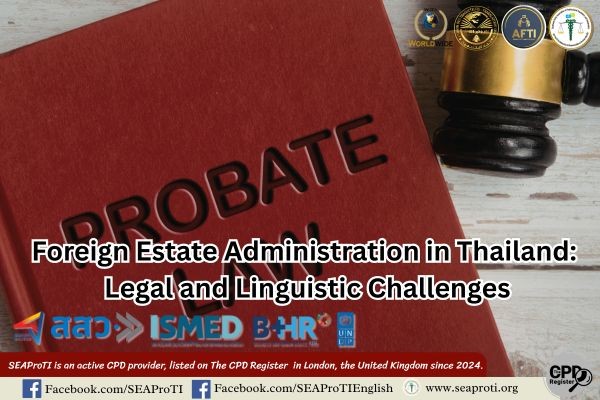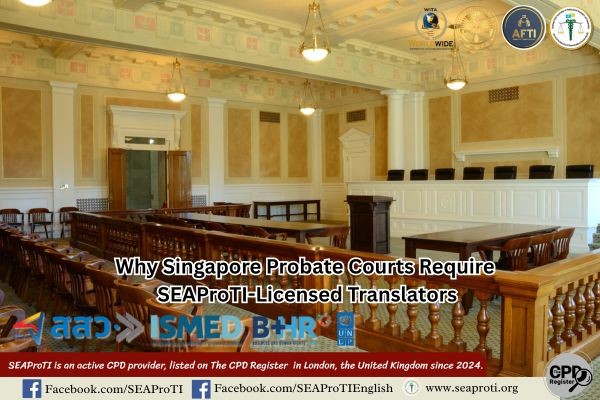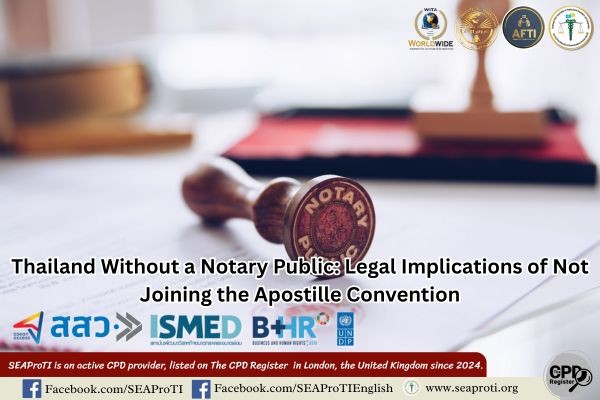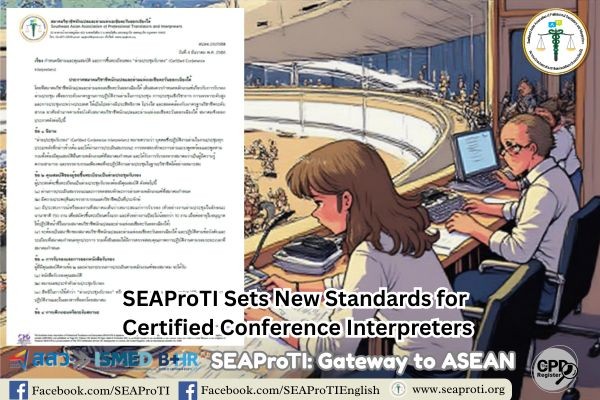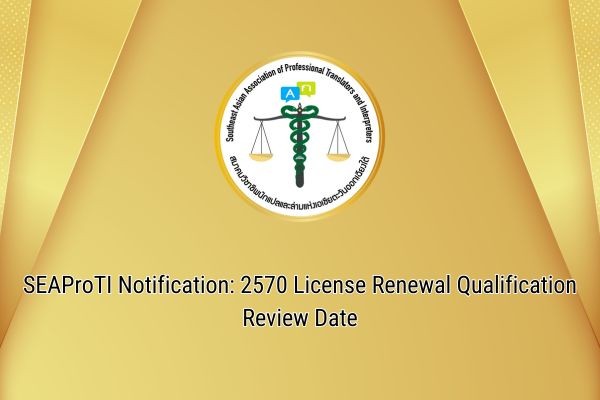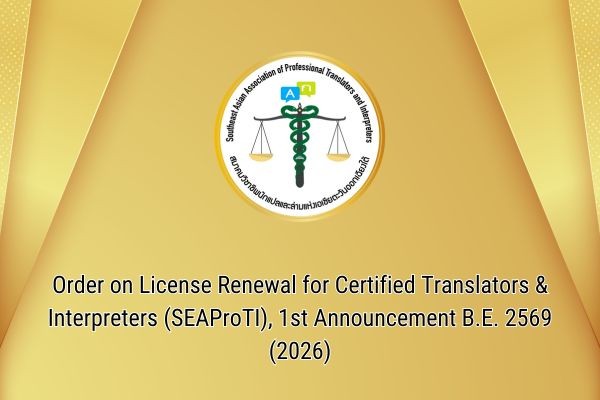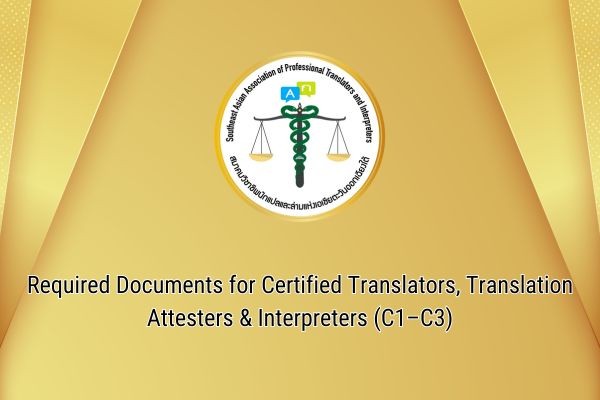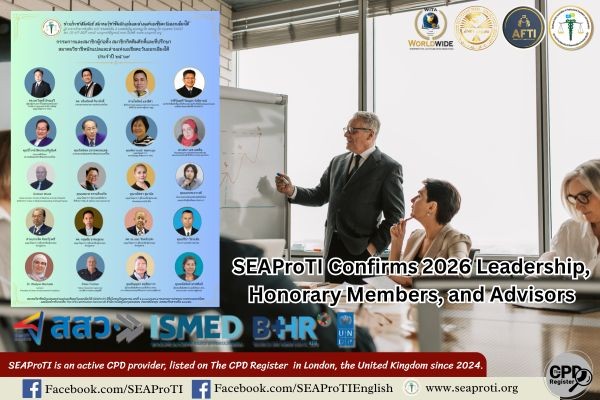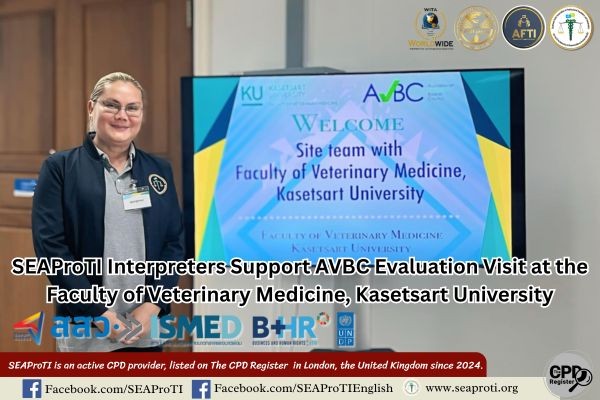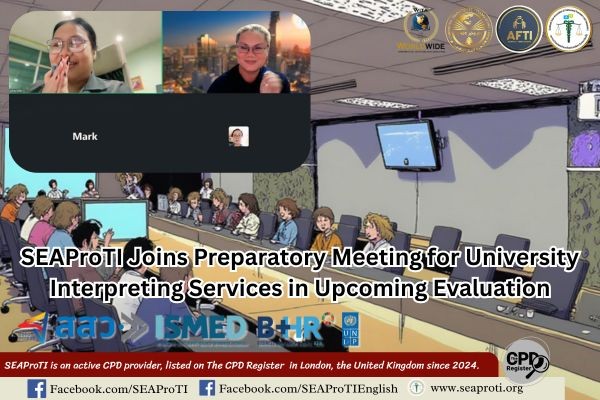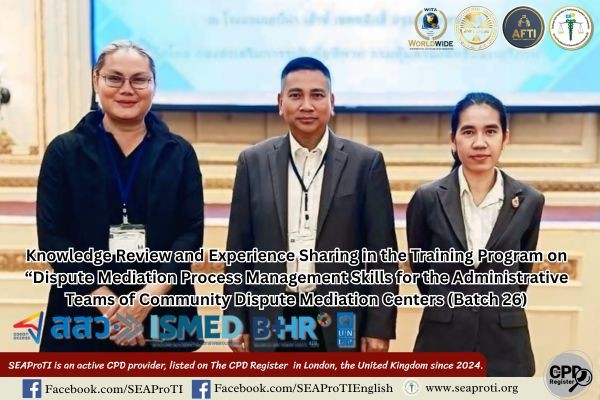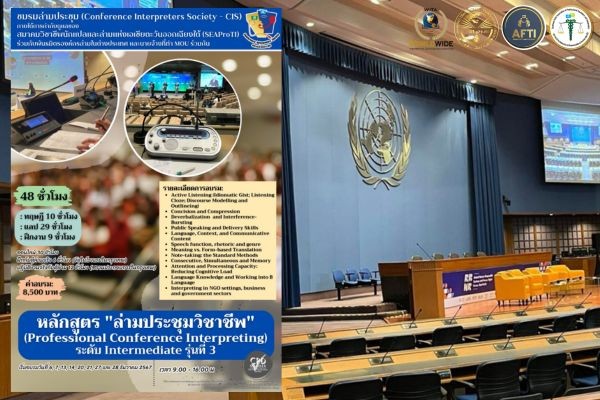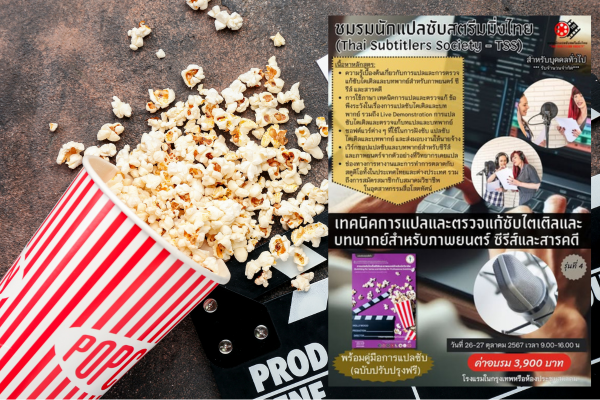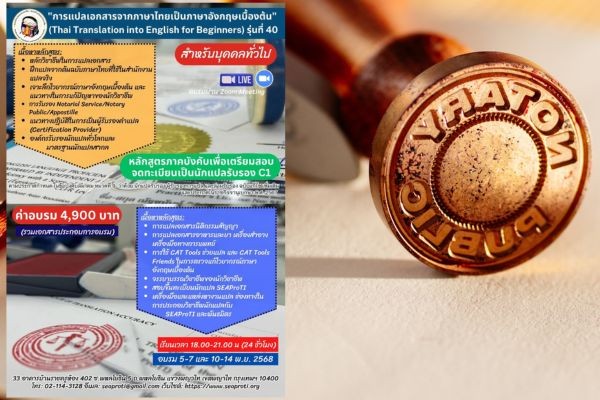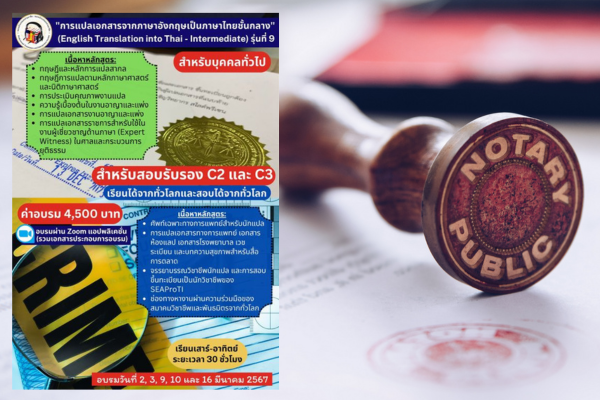Challenges of Being an Expert Witness in Thai Forensic Linguistics
In an Era Where Thai People Do Not Use Words According to the Dictionary
Author: Wanitcha Sumanat, the president of the Southeast Asian Association of Professional Translators and Interpreters
12 August 2025, Bangkok – This article examines the challenges faced by expert witnesses in Thai forensic linguistics within the Thai judicial process, where contemporary language use often diverges from standard dictionary definitions, such as those in the Royal Institute Dictionary. Such divergence stems from linguistic change, the influence of social media, and the creation of sociolect-specific meanings. The article compares dictionary-based definitions with contemporary usage, discusses the implications for court testimony, and proposes practical strategies to maintain the accuracy and credibility of forensic linguistic interpretation.
Keywords: forensic linguistics, expert witness, dictionary, contemporary meaning, Thai language
Introduction
Language constantly evolves according to social, cultural, and technological contexts (Labov, 1994). In Thailand, such changes are evident in the use of words whose meanings differ from the definitions in standard dictionaries, such as the Royal Institute Dictionary, which is often treated as an authoritative linguistic reference in legal contexts. This presents significant challenges for forensic linguistics experts serving as witnesses in court, as the meaning of certain expressions may not align with the understanding of the general public or litigants in a given case.
Dictionary Meaning vs. Contemporary Meaning
Standard dictionaries aim to document meanings that are widely accepted (Royal Society of Thailand, 2011). In practice, however, language users often create new meanings or alter existing ones. For example, the Thai word ดราม่า (“drama”) is defined as “a theatrical play” but is used in social media to mean “a conflict or heated controversy.” In legal proceedings involving such terms, it is insufficient to rely solely on dictionary definitions (Crystal, 2008).
Factors Contributing to Semantic Change
- Influence of Social Media – New words and expressions spread rapidly, such as แฉ (“expose”) or โป๊ะแตก (“being caught red-handed”).
- Borrowing from Other Languages – Terms like แชร์ (“share”) and คอนเทนต์ (“content”) have evolved in meaning, diverging from their source languages.
- Dialect and Sociolect Usage – A single word may have different meanings depending on the group. For instance, หมุน (“spin”) can mean “finding money to pay off a debt” in local business communities.
Implications for Forensic Linguistic Expert Testimony
- Credibility in Court – If an expert relies solely on dictionary definitions, opposing counsel may argue that such interpretations fail to reflect actual language use.
- Burden of Contextual Explanation – Experts must demonstrate that contemporary meanings are supported by linguistic evidence and adhere to scientific methodology.
- Risk of Misinterpretation – Isolating words from their context may lead to flawed conclusions and potentially affect case outcomes.
Recommended Practices
Use of Contemporary Language Evidence
Compile data from large-scale linguistic corpora containing materials from print and online media produced during the relevant time frame (McEnery & Hardie, 2012).
Contextual Analysis
Interpret terms based on sentence-level context, situational factors, and the relationship between interlocutors.
Multiple Source References
Combine standard dictionaries with social media data, witness interviews, and analysis of group-specific language use.
Case-Specific Glossary Development
Create a case-specific glossary of key terms with documented evidence of actual usage to assist the court’s understanding.
Conclusion
In an era of rapid linguistic change in Thai, forensic linguistics experts must adapt their methodologies by moving beyond sole reliance on standard dictionaries. They should incorporate contemporary language evidence and contextual analysis to ensure interpretations are accurate, reflect actual usage, and can be convincingly explained to the court with both methodological rigor and credibility.
References
- Crystal, D. (2008). A dictionary of linguistics and phonetics (6th ed.). Blackwell Publishing.
- Labov, W. (1994). Principles of linguistic change: Internal factors. Blackwell Publishing.
- McEnery, T., & Hardie, A. (2012). Corpus linguistics: Method, theory and practice. Cambridge University Press.
- Royal Society of Thailand. (2011). Royal Institute Dictionary B.E. 2554 (2011). Bangkok: Royal Society of Thailand.
About SEAProTI Certified Translators, Certification Providers, and Interpreters
The Southeast Asian Association of Professional Translators and Interpreters (SEAProTI) has published official guidelines and eligibility criteria for individuals seeking registration as Certified Translators, Translation Certification Providers, and Certified Interpreters under Chapter 9 and Chapter 10 of the Royal Thai Government Gazette, issued by the Secretariat of the Cabinet, Office of the Prime Minister, on 25 July 2024 (Vol. 141, Part 66 Ng, p. 100). Full text available at: The Royal Thai Government Gazette
ความท้าทายในการเป็นพยานผู้เชี่ยวชาญด้านนิติภาษาศาสตร์ไทย ในวันที่คนไทยไม่ได้ใช้ศัพท์ภาษาไทยตามพจนานุกรม
ผู้เขียน วณิชชา สุมานัส นายกสมาคมวิชาชีพนักแปลและล่ามแห่งเอเชียตะวันออกเฉียงใต้ (SEAProTI)
12 สิงหาคม 2568, กรุงเทพมหานคร – บทความนี้วิเคราะห์ประเด็นความท้าทายที่พยานผู้เชี่ยวชาญด้านนิติภาษาศาสตร์ไทยเผชิญในกระบวนการยุติธรรมไทย เมื่อภาษาที่ใช้ในสังคมไทยปัจจุบันมีการเบี่ยงเบนจากความหมายตามพจนานุกรมมาตรฐาน เช่น พจนานุกรมฉบับราชบัณฑิตยสถาน อันเนื่องมาจากการเปลี่ยนแปลงของภาษา การใช้คำในสื่อสังคมออนไลน์ และการสร้างความหมายเฉพาะกลุ่ม (sociolect) บทความนำเสนอการเปรียบเทียบความหมายตามพจนานุกรมกับความหมายร่วมสมัย อธิบายผลกระทบต่อการให้การเป็นพยานในศาล และเสนอแนวทางปฏิบัติเพื่อรักษาความน่าเชื่อถือและความถูกต้องของการตีความภาษาตามหลักนิติภาษาศาสตร์
คำสำคัญ: นิติภาษาศาสตร์, พยานผู้เชี่ยวชาญ, พจนานุกรม, ความหมายร่วมสมัย, ภาษาไทย
บทนำ
ภาษามีความเปลี่ยนแปลงอย่างต่อเนื่องตามบริบททางสังคม วัฒนธรรม และเทคโนโลยี (Labov, 1994) ในประเทศไทย ปรากฏการณ์ดังกล่าวเห็นชัดจากการใช้คำที่มีความหมายต่างไปจากนิยามตามพจนานุกรมมาตรฐาน เช่น พจนานุกรมฉบับราชบัณฑิตยสถาน ซึ่งเป็นแหล่งอ้างอิงทางภาษาที่ใช้กันในเชิงกฎหมาย ปัญหานี้สร้างความท้าทายอย่างมากต่อผู้เชี่ยวชาญด้านนิติภาษาศาสตร์ซึ่งทำหน้าที่เป็นพยานในศาล เพราะความหมายของถ้อยคำอาจไม่ตรงกับการรับรู้ของประชาชนหรือคู่ความในคดี
ความหมายตามพจนานุกรม vs. ความหมายร่วมสมัย
พจนานุกรมมาตรฐานมีจุดมุ่งหมายในการเก็บบันทึกความหมายที่ได้รับการยอมรับทั่วไป (ราชบัณฑิตยสภา, 2554) แต่ในทางปฏิบัติ ผู้ใช้ภาษาในสังคมอาจสร้างความหมายใหม่หรือเปลี่ยนความหมายเดิม ตัวอย่างเช่น คำว่า “ดราม่า” ตามพจนานุกรมหมายถึง “ละคร” แต่ในสื่อสังคมออนไลน์หมายถึง “เหตุการณ์ขัดแย้งหรือวิพากษ์วิจารณ์รุนแรง” การตีความในคดีที่มีคำดังกล่าว จึงไม่สามารถอ้างเพียงนิยามพจนานุกรมได้ (Crystal, 2008)
ปัจจัยที่ทำให้ความหมายภาษาเปลี่ยนแปลง
- อิทธิพลของสื่อสังคมออนไลน์ – คำและสำนวนใหม่แพร่กระจายรวดเร็ว เช่น “แฉ,” “โป๊ะแตก”
- การยืมคำจากภาษาอื่น – คำอย่าง “แชร์,” “คอนเทนต์” ถูกปรับความหมายให้ต่างจากต้นภาษา
- ภาษาถิ่นและภาษากลุ่มย่อย (sociolect) – คำเดียวกันมีความหมายต่างกันตามกลุ่ม เช่น “หมุน” หมายถึง “หาเงินมาใช้หนี้” ในกลุ่มธุรกิจท้องถิ่น
ผลกระทบต่อการเป็นพยานผู้เชี่ยวชาญด้านนิติภาษาศาสตร์
- ความน่าเชื่อถือในศาล – หากผู้เชี่ยวชาญอ้างเพียงพจนานุกรม ฝ่ายตรงข้ามสามารถโต้แย้งว่าไม่สะท้อนการใช้ภาษาจริง
- ภาระการอธิบายบริบท – ต้องอธิบายต่อศาลว่า ความหมายร่วมสมัยมีหลักฐานรองรับและเป็นไปตามหลักวิชาการ
- ความเสี่ยงจากการตีความผิดพลาด – การตีความคำโดยไม่พิจารณาบริบทอาจทำให้ข้อสรุปคลาดเคลื่อน ส่งผลต่อผลคดี
แนวทางปฏิบัติที่แนะนำ
การใช้หลักฐานภาษาร่วมสมัย
รวบรวมข้อมูลจากคลังภาษาขนาดใหญ่ (corpus) ที่มีเนื้อหาจากสื่อสิ่งพิมพ์และออนไลน์ในช่วงเวลาที่เกี่ยวข้องกับคดี (McEnery & Hardie, 2012)
การวิเคราะห์เชิงบริบท (Contextual Analysis)
ตีความคำจากบริบททั้งประโยค สถานการณ์ และความสัมพันธ์ระหว่างคู่สนทนา
การอ้างอิงหลายแหล่ง
ใช้พจนานุกรมมาตรฐานควบคู่กับข้อมูลโซเชียลมีเดีย สัมภาษณ์พยาน และการวิเคราะห์ภาษากลุ่มเฉพาะ
การจัดทำพจนานุกรมเฉพาะคดี
สร้างเอกสารรวบรวมคำสำคัญในคดี พร้อมหลักฐานการใช้จริง เพื่อให้ศาลใช้ประกอบการพิจารณา
สรุป
ในยุคที่ภาษาไทยมีการเปลี่ยนแปลงอย่างรวดเร็ว ผู้เชี่ยวชาญด้านนิติภาษาศาสตร์ต้องปรับวิธีการทำงานโดยไม่พึ่งพาเพียงพจนานุกรมมาตรฐาน แต่ต้องใช้หลักฐานภาษาร่วมสมัยและการวิเคราะห์เชิงบริบท เพื่อให้การตีความมีความถูกต้อง สอดคล้องกับการใช้ภาษาจริง และสามารถอธิบายต่อศาลได้อย่างมีเหตุผลและเชื่อถือได้
เอกสารอ้างอิง
- Crystal, D. (2008). A dictionary of linguistics and phonetics (6th ed.). Blackwell Publishing.
- Labov, W. (1994). Principles of linguistic change: Internal factors. Blackwell Publishing.
- McEnery, T., & Hardie, A. (2012). Corpus linguistics: Method, theory and practice. Cambridge University Press.
- ราชบัณฑิตยสภา. (2554). พจนานุกรมฉบับราชบัณฑิตยสถาน พ.ศ. 2554. กรุงเทพฯ: ราชบัณฑิตยสภา.
เกี่ยวกับนักแปลรับรอง ผู้รับรองการแปล และล่ามรับรองของสมาคมวิชาชีพนักแปลและล่ามแห่งเอเชียตะวันออกเฉียงใต้
สมาคมวิชาชีพนักแปลและล่ามแห่งเอเชียตะวันออกเฉียงใต้ (SEAProTI) ได้ประกาศหลักเกณฑ์และคุณสมบัติผู้ที่ขึ้นทะเบียนเป็น “นักแปลรับรอง (Certified Translators) และผู้รับรองการแปล (Translation Certification Providers) และล่ามรับรอง (Certified Interpreters)” ของสมาคม หมวดที่ 9 และหมวดที่ 10 ในราชกิจจานุเบกษา ของสำนักเลขาธิการคณะรัฐมนตรี ในสำนักนายกรัฐมนตรี แห่งราชอาณาจักรไทย ลงวันที่ 25 ก.ค. 2567 เล่มที่ 141 ตอนที่ 66 ง หน้า 100 อ่านฉบับเต็มได้ที่: นักแปลรับรอง ผู้รับรองการแปล และล่ามรับรอง
